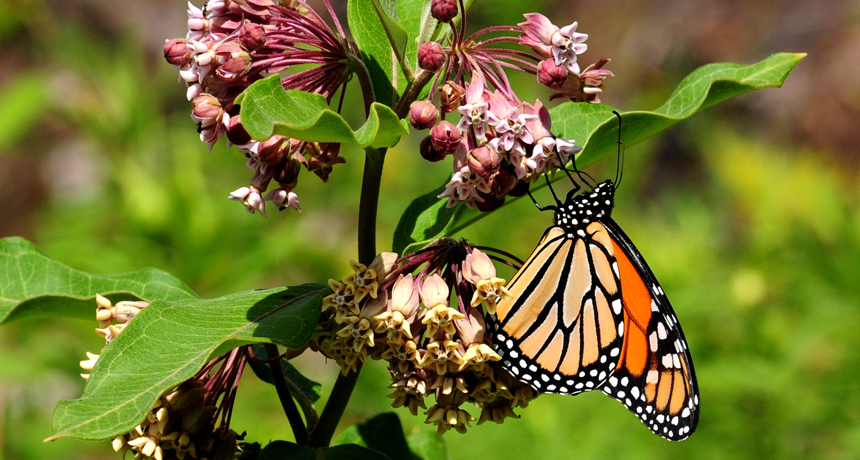Salted butterflies
The salt used to melt slick winter ice can alter the bodies of summer's butterflies

Monarch butterflies develop differently when they get extra sodium in their diet — such as from the salt used to melt winter ice.
SENEY NATURAL HISTORY ASSOCIATION/FLICKR (CC BY-SA 2.0)
The salt used to melt the slick ice on winter roads can alter the brains and muscles of butterflies the following summer. That’s the finding of a new study conducted with monarch caterpillars.
Before they spin a cocoon and emerge with wings, the caterpillars feed on the leaves of milkweeds, oaks and other plants. Researchers collected the leaves from milkweeds growing near a country road in Minnesota. They compared them to those from milkweeds growing at least 100 meters (328 feet) away. Greens from near the road had as much as 30 times more sodium, the new study found. Sodium is an ingredient in normal road salt.
Sodium is also essential to animals, including humans. People often eat too much of it, which can be bad for their health. Animals, by contrast, often struggle to get enough to stay healthy. The quest for sodium has driven animals to hunt for the element in creative ways — such as by eating dirt, Emilie Snell-Rood told Science News. An ecologist at the University of Minnesota in St. Paul, she led the new study. Some butterflies drink the tears of other animals, potentially in search of more sodium. Monarch butterflies must get their salt from the milkweed plants that make up most of their diet.
Snell-Rood’s team fed the milkweed greens they collected to monarch caterpillars. Males who dined on leaves from the sodium-rich plants developed bigger muscles in their thorax. That’s the middle section of their bodies. Female butterflies showed different effects. They developed larger eyes — a sign of bigger brains — than the females that had eaten leaves of milkweeds growing farther away.
Snell-Rood’s team then repeated their experiments in the lab with a second species: white cabbage butterflies. The males and females of these species responded to a diet that had bonus sodium just as the monarchs had. The researchers described their results June 9 in the Proceedings of the National Academy of Sciences.
These data show for the first time how eating road salt can alter a butterfly’s body, Snell-Rood says. Scientists don’t know if those effects are good, bad or unimportant. More research will be needed before biologists can draw firm conclusions, she explains.
Nathan Morehouse called the study “both exciting and worrying.” A biologist at the University of Pittsburgh in Pennsylvania, he did not work on the new study. But he, too, has studied the effects on butterflies of what they eat.
Scientists don’t know why males and females responded differently in the new study. Males do compete with each other to get mates, so perhaps the extra muscle gave them the ability to outfly their rivals, Morehouse speculates. And females have to scout safe spots on the right plants on which to lay eggs. Larger eyes and extra brain power might aid them in finding those places. Snell-Rood wanted to test even higher doses of sodium, but too many of the insects died after eating a diet with the highest amounts of salt.
Stuart Findlay is an ecologist at the Cary Institute of Ecosystem Studies in Millbrook N.Y. He told Science News that the long-term effects of salt on wildlife are “very poorly understood.”
Power Words
biology The study of living things. The scientists who study them are known as biologists.
ecology A branch of biology that deals with the relations of organisms to one another and to their physical surroundings. A scientist who works in this field is called an ecologist.
insect A type of arthropod that as an adult will have six segmented legs and three body parts: a head, thorax and abdomen. There are hundreds of thousands of insects, which include bees, beetles, flies and moths.
parts per (million, billion or trillion) A measurement of extremely small concentrations of one chemical dissolved in another. For example, a solution of 300 parts per billion of sodium in water would mean that there are 300 sodium atoms for every billion water molecules.
sodium A soft, silvery metallic element that will interact explosively when added to water. It is also a basic building block of table salt (a molecule of which consists of one atom of sodium and one of chlorine: NaCl).
thoraxThe middle section of the body of an insect. Between the head and the abdomen, it bears the legs and wings.







